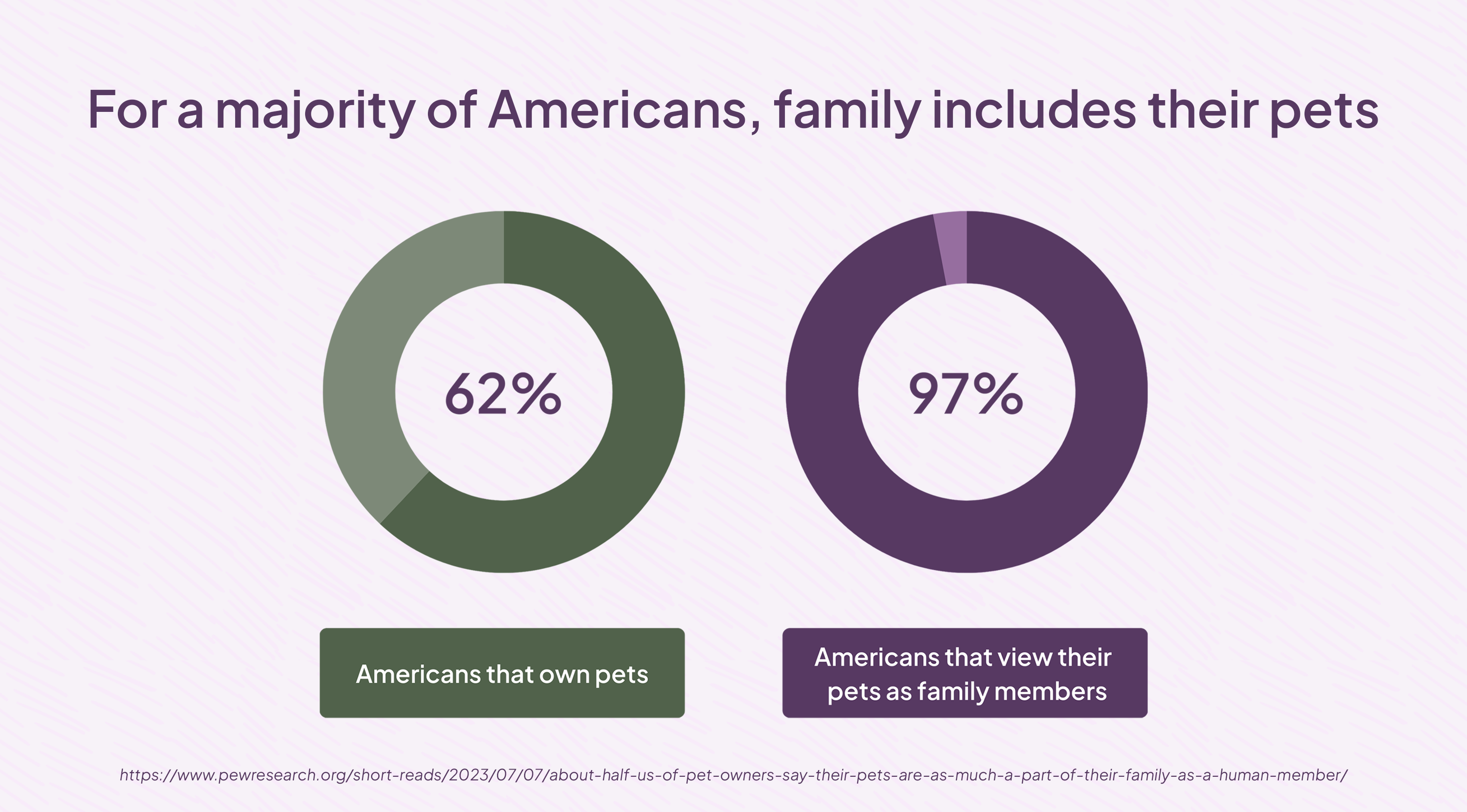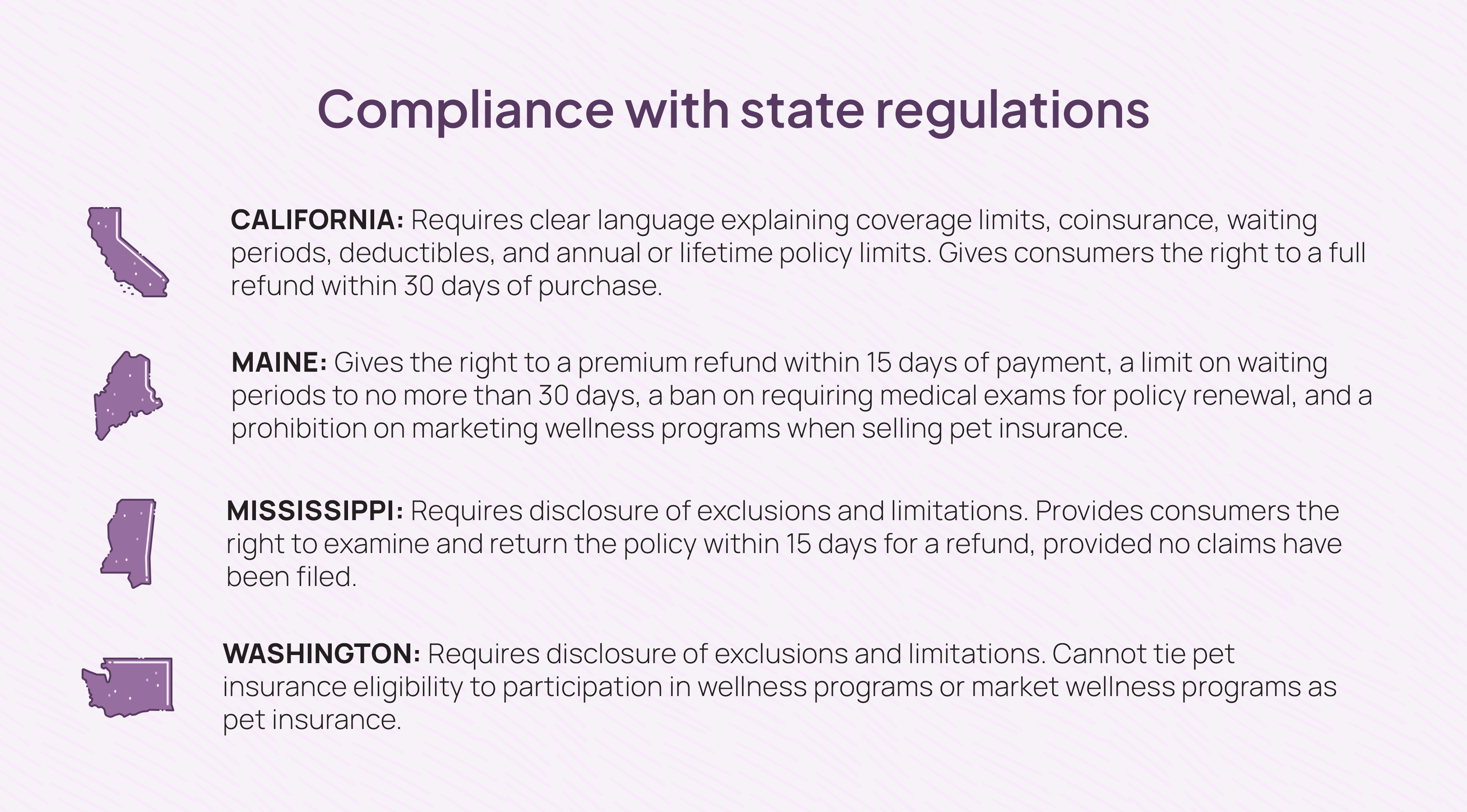
Navigating the Legal Landscape of Pet Insurance as an Employee Benefit
Thinking about adding pet benefits to your employee benefit package? Before you do, it's important to take a look at the legal requirements at the federal and state level. You'll want to make sure you're in compliance before offering this in-demand benefit to your employees.
As an employer, are you tapping into the benefits that truly matter to your team? And what better way to show you care than by addressing an essential part of their lives—their pets? A Pew Research Center survey revealed that 62% of Americans own pets, and 97% view them as family members.

With these statistics, the trend is clear: pets are a priority for most Americans, including your employees. Given this close relationship, it’s no surprise that offering voluntary pet benefits is becoming a more attractive perk. According to the Goldman Sachs Ayco 2023 Benefits and Compensation Trends Report, the inclusion of pet insurance in benefit packages has surged by 120% in just three years.
Clearly, pet insurance isn’t just a nice-to-have anymore; it’s a strategic benefit that can play a crucial role in your overall employee’s benefits package. As you aim to attract and retain top talent by enhancing your voluntary benefits offerings, understanding the legal intricacies of including pet insurance is vital. Read on as we guide you through the essential legal frameworks for offering pet insurance as a voluntary benefit.
Legal Guidelines for Offering Pet Insurance as a Benefit
When adding pet insurance to your employee benefits package, it’s essential to comply with both federal and state regulations, which can sometimes differ significantly. Here are several key legal aspects you should know:
Compliance with Federal Laws
When adding pet insurance to your employee benefits offerings, it’s important to understand that, at the federal level, there are no specific laws that directly govern pet insurance. This type of insurance is considered property and casualty insurance, and regulation primarily falls to individual state insurance commissions.
However, understanding broader guidelines provided by entities like the National Association of Insurance Commissioners (NAIC) through the Pet Insurance Model Act can be helpful. This model act aims to provide a framework for states to enhance consumer protections in pet insurance policies. Key elements of this act include:
Consumer protections: The act mandates comprehensive disclosures about the terms of coverage, including waiting periods, policy limits, and exclusions. This means that, as an employer, you need to ensure that any pet insurance provider you partner with is transparent about their policies.
Preexisting conditions: The act places restrictions on how insurers can deny claims based on preexisting conditions. It requires that the insurer prove that such a condition applies before denying a claim, shifting the burden of proof away from the policyholder.
Wellness programs: To prevent confusion, the act stipulates that wellness programs must be clearly distinguished from insurance policies. Communicating these distinctions to your employees helps them choose the right product for their needs.
Training for providers: This training is essential for providers to offer accurate and useful information to potential buyers. As such, you should partner with pet insurance providers who invest in training their representatives, who can, in turn, better educate your employees about their options.
While the NAIC’s model laws serve as a recommended standard, they are not enforceable at the federal level. States have the autonomy to adopt, modify, or disregard these recommendations.
Compliance With State Regulations
Understanding the specific regulations in your state is essential when offering pet insurance as a voluntary benefit. State laws can vary widely, and being informed will help you choose the right policy and stay compliant. Here are some key regulations in states that have enacted specific laws regarding pet insurance:
California
California was the first state to adopt comprehensive legislation specific to pet insurance, which took effect in 2015. This law focuses on clear disclosures to consumers. It requires policies to contain clear language explaining coverage limits, coinsurance, waiting periods, deductibles, and annual or lifetime policy limits.
The legislation states that policies must allow consumers to return them for a full refund within 30 days of purchase. When offering pet insurance in California, ensure your employees receive clear, comprehensive information about their policies. Partner with insurers that comply with these transparency requirements to avoid any legal issues and enhance employee trust.
Maine
Maine adopted rules on pet insurance in 2022, becoming the second state to enact such legislation. This law is based on the NAIC model law and aims to provide clarity and consistency in policy provisions. It includes giving consumers the right to a premium refund within 15 days of payment, a limit on waiting periods to no more than 30 days, a ban on requiring medical exams for policy renewal, and a prohibition on marketing wellness programs when selling pet insurance.
Mississippi
In 2023, Mississippi adopted laws governing pet insurance, including regulations proposed by the Mississippi Department of Insurance. These laws require insurers to disclose policy exclusions and limitations, such as preexisting conditions, hereditary disorders, congenital anomalies, and chronic conditions.
The law also provides consumers the right to examine and return the policy within 15 days for a refund, provided no claims have been filed. When offering voluntary pet benefits in Mississippi, you should ensure that the policies you offer are clear about exclusions and limitations.
Washington
Washington’s pet insurance bill, which became effective on January 1, 2024, is based on NAIC model legislation and shares similarities with Maine’s law. It requires insurers to disclose exclusions, such as preexisting conditions, hereditary disorders, and chronic conditions. Insurers must also inform policyholders of any limitations, such as waiting periods, deductibles, and policy limits.
Additionally, insurers cannot tie pet insurance eligibility to participation in wellness programs or market wellness programs as pet insurance. In Washington, anyone selling pet insurance must complete the required training and become licensed by the Office of the Insurance Commissioner. This means you must partner with certified providers to ensure your employees receive accurate, reliable information from knowledgeable professionals.

Comparing Federal and State Guidelines
While federal regulations don’t specifically govern pet insurance, they do establish broad employment and benefits laws you must follow. For instance, federal guidelines generally require that any benefit you offer, including pet insurance, should be provided equitably to all eligible employees to avoid discrimination.
Since there aren’t any specific laws addressing pet insurance at the federal level, the primary responsibility falls on individual states to regulate it. This means your compliance will heavily depend on the specific state laws where you operate. Therefore, you need to choose providers that comply with these state-specific regulations to offer transparent and trustworthy policies to your employees.
Partnering with Pet Benefit Solutions
Understanding the legal landscape of pet insurance is crucial for offering it as a valuable employee benefit. While there are no specific federal regulations, state laws provide detailed guidelines you must follow. Navigating these regulations ensures that you provide valuable and compliant voluntary pet benefits to your employees.
If you’re ready to enhance your voluntary benefits package with pet insurance, consider Pet Benefit Solutions. As the leading provider specializing in both pet insurance and alternatives, we offer innovative plans and exceptional customer care. From comprehensive health insurance to everyday savings, we have multiple options to support your employees and their pets.
Contact us today to learn more about how we can help you provide top-notch pet benefits.



